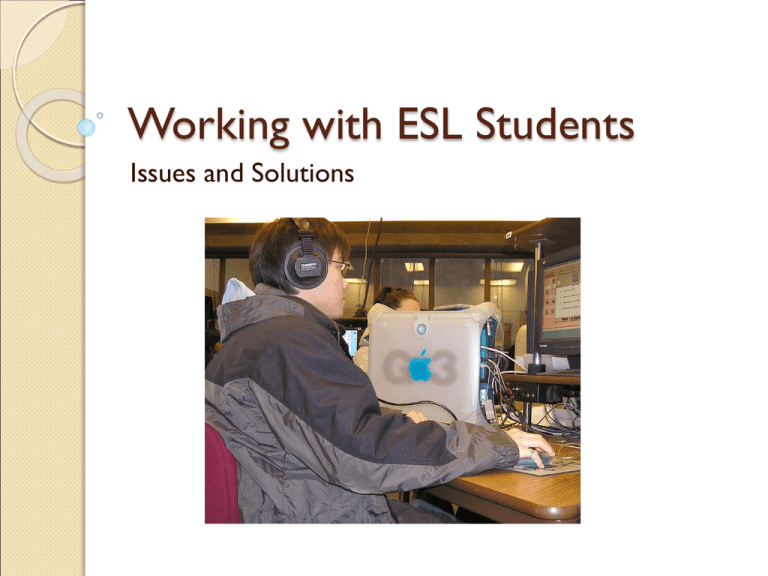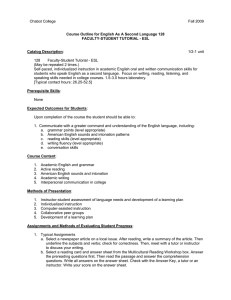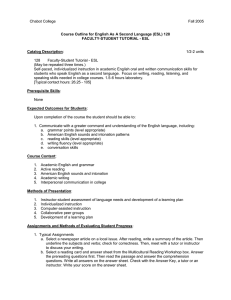Working with ESL Students Issues and Solutions
advertisement

Working with ESL Students Issues and Solutions Common Characteristics of an ESL Session Research shows tutoring sessions with ESL tend to: ◦ Be more directive than non-directive ◦ Focus more on sentence level or lower order concerns ◦ Have a greater emphasis on editing To Direct, or Not to Direct? Use your judgment, but keep the following in mind: ◦ Every student is an individual with a different knowledge base. ◦ ESL Students often know the rules and terminology for English grammar better than native speakers. ◦ You must never do the work for the student. This includes correcting homework. ◦ Try the non-directive approach first, but be willing to shift to a more directive approach when necessary. The Burning Question: THERE ARE SO MANY ERRORS! WHERE DO I START? I WANT TO FIX EVERYTHING. Be Realistic Adult ESL students will never achieve complete fluency. If you correct all their errors, you become a proofreader instead of a tutor. You do not want to overwhelm the student. Focus on higher order concerns first. Negotiate a strategy for addressing lower order concerns. Global Versus Local Errors Global Errors = Affects the reader’s comprehension of a text ◦ Word choice ◦ Relative clauses ◦ Word order Local Errors = Usually do not affect the reader’s comprehension of the text ◦ Articles ◦ Prepositions ◦ Pronoun agreement Two Options to Negotiate One: Have the student agree you will only focus on global errors in your review of the paper. Two: Have the student agree you will only review the first paragraph or page for grammar errors, looking for patterns of error, and leave the rest for him or her to fix. The Interaction Hypothesis ESL students can learn English through conversation with native speakers. If the message in the text is unclear, the tutor and tutee can discuss the intended meaning and negotiate how to revise the text. This ensures the tutor fully understands the intended meaning and also gives the student the opportunity to revise his or her own text while developing language proficiency. Reading the Paper…. Leave the choice to read the paper out loud to the student. There are Pros and Cons to both: ◦ Con: Sometimes pronunciation issues may prove a distraction. ◦ Pro: Students will hear and correct their own errors. Negotiate the strategy with the student. ◦ “Would you like to read the paper out loud, or would you rather have me read the paper out loud?” Discussing Errors One interactive way to discuss grammar errors is to: ◦ Point to the error in the sentence ◦ Ask the student what he or she thinks might be missing or wrong ◦ Ask leading questions ◦ Give students time to process the question before asking another leading question ◦ (Note: The more specific you can be with your grammar terminology and rules, the more effective this strategy) Example Tutor: Hmm. Do you think something is unclear here? Student:Yes. Tutor: What? Student: I don’t know. Tutor: Is there a punctuation mark missing? Student: Should I have a comma there? Tutor:Yes. Can you explain why? Student: It’s a run-on sentence. To Summarize It is OK to use more directive and informative strategies with ESL students. Make sure to negotiate the different strategies you will use with each student. Focus on higher order issues first. At the sentence level, focus on global issues that interfere with comprehension. Make the session interactive

